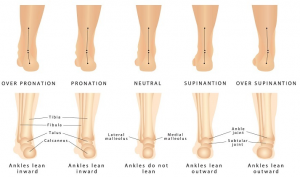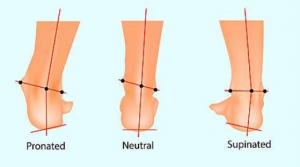Pronation and Supination of the Foot
Pronation is a natural motion of your foot during walking and running. Your gait can show a pattern of neutral pronation, overpronation, or supination (underpronation). The stresses of overpronating or supinating have been linked to a greater risk of injuries.
Motion-control shoes and orthotics may be recommended if you are an overpronator, while flexible and cushioned shoes are better for people who supinate. Learn about these gait patterns and what you can do to address them if they are causing you pain (many people over-or under-pronate with no ill effects).

Normal Pronation
Pronation refers to the natural side-to-side movement of the foot as you walk or run. Your foot normally rolls a bit inward with each step.
Here is what happens during normal pronation:
- All of the toes aid in push-off in normal pronation, but the big toe and second toe do more of the work while the others stabilize.
- During push-off, the sole of the foot is facing the rear of your body in pronation and is not tilted so the sole is facing either inward or outward.
- From the time your heel strikes the ground, your arch begins to flatten and cushion the shock.
- If you have a neutral gait, your foot should begin to roll outward with the toe-off.
- The arch rises and stiffens to provide stability as the foot rolls upward and outward.
- Your weight shifts to the outside of your foot and then back to the big toe.
The posterior tibialis muscle primarily controls pronation. It is an eccentric action in gait, not a concentric action, meaning the muscle lengthens instead of contracting.
Overpronation
In overpronation, the ankle rolls too far downward and inward with each step. It continues to roll when the toes should be starting to push off. As a result, the big toe and second toe do all of the push-off and the foot twists more with each step.
Overpronation is seen more often in people with flat feet, although not everyone with flat feet overpronates.
Overpronation can lead to strain on the big toe and second toe and instability in the foot. The excessive rotation of the foot leads to more rotation of the tibia in the lower leg, with the result being a greater incidence of shin splints (also called medial tibial stress syndrome) and knee pain.
Overpronation can also lead to excessive strain on the posterior tibialis tendon, causing shin splints and posterior tibialis tendon dysfunction in older adults. Motion-control shoes, insoles, and orthotics are designed to correct your foot motion in overpronation.
Supination (Underpronation)
Supination is a rolling motion to the outside edge of the foot during a step. The foot naturally supinates during the toe-off stage of your stride as the heel first lifts off the ground, providing leverage to help roll off the toes.
However, with supination, the foot does not pronate enough at the toe-off stage. This results in all of the work being done by the outer edge of the foot and smaller toes, placing extra stress on the foot. Supination is seen more often in people with high, rigid arches that don’t flatten enough during a stride.
Supination can be associated with running injuries
such as ankle injury, iliotibial band syndrome, Achilles tendonitis, and plantar fasciitis. Shoes that are well-cushioned and flexible are best for people who supinate.

Causes
While identifying supination or pronation is easy, it can be difficult to pinpoint the exact cause. First, many people are born with their feet doing one or the other due to high or low arches or legs that are seemingly uneven (which could be due to hip alignment rather than actual length).
However, injuries can also cause supination or pronation issues, particularly when discomfort is ignored. When the body is experiencing pain, it is a waving red flag that attention is necessary. Ignoring things like soreness, twists, sprains, leg, hip, knee, or back pain can only exacerbate an injury. Typically, rest is just one remedy to an issue, but not the only remedy. If someone is already experiencing knee or back pain, for instance, they will likely adjust their gait to accommodate their pain, which can lead to overpronation.
A third possible cause can be lifestyle. People who are on their feet for excessive amounts of time might experience supination or pronation to try and find comfort and relief. Running may similarly cause issues, particularly when someone trains at a pace that can lead to injury. It is also possible that a person’s weight can lead to an uneven gait, especially if someone has recently gained or lost a significant amount of weight and their body is adjusting to the change.
Treatment
The good news is that treatment of supination or pronation is easily achieved, which can help reduce long-term discomfort and susceptibility to injury. The most effective treatment for supination or pronation is a customized orthotic insole in shoes. But, note the need for this to be customized. Over-the-counter solutions will not provide the relief necessary to correct the issue.
The first step to treatment is getting a quick foot scan. Chiropractors and physical therapists throughout the country have Foot Levelers scanning technology in their office and can scan a patient’s feet in less than two minutes, and get the results immediately. A foot scan will determine how someone is distributing their weight on their feet, which informs the design of their customized orthotic insoles. After a scan, an order can be placed for personalized insoles that fit right into your shoes, to provide immediate relief and improved mobility.
By wearing Foot Levelers custom orthotics, the entire body achieves balance, starting with the feet. After a few months of wearing orthotics, the wear on shoes should become more equal. Not to mention, any discomfort caused by supination or pronation will subside as the body regains balance and alignment. Lower back pain, knee pain, and an increased risk of ankle injuries can be greatly reduced, if not totally eliminated, through Foot Levelers custom orthotics.
https://aideastep.com/pronation-and-supination-foot-wedge-insoles-ideastep/
https://aideastep.com/insole-to-correct-pronation/
Hot blogs:
The Easiest Custom Insoles: Heat Moldable Insoles
Custom insoles, also known as orthotic insoles, are designed to provide personalized support and comfort for individuals with various foot conditions. In [...]
Children’s Insole Size Conversion Chart
The standard sizes for shoe insoles may vary from country to country, making it a headache to choose the right insole for [...]
Do custom orthotics need to be made by a doctor personally?
Custom orthotics do not necessarily need to be made by a doctor personally. While doctors, specifically podiatrists or orthopedic specialists, are often [...]
Do NBA players use custom insoles?
Custom insoles are not only helpful for people with foot health issues, but they also play a significant role in targeting the [...]
